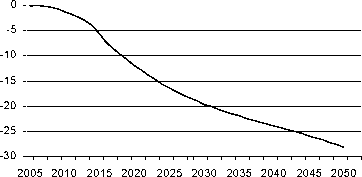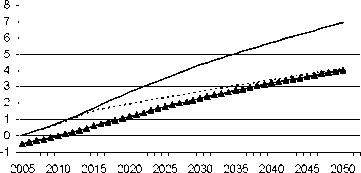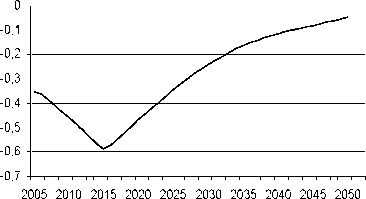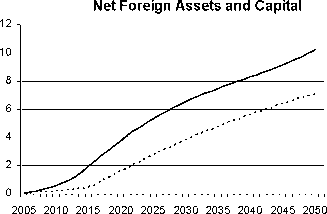interest rates by about 60 BP in the long run and lead to an increase in the capital stock of about
7%. Notice, however, a significant part of the additional savings would flow abroad. Foreign
wealth as a per cent of GDP would increase by about 10% points, while domestic capital as a per
cent of GDP would only increase by 7% points. Associated with the reform is a redistribution of
financial wealth from pensioners to worker households. These results compare to a reduction of
the real interest rate of 275 BP in the closed economy model of Gertler, accompanied by an
increase in the capital stock of 20%.
Real Interest Rate

Figure 2: Reducing PAYG Pensions (2.5% of GDP)
GDP, Consumption, Capital

I Capital c Consumption .......GDP ∣
Consumption to GDP ratio


Capital to GDP ratio------Net foreign assets
One striking feature of this comparison is the relatively small crowding out effect of both
government debt and the PAYG social security system. Two features of the model are probably
crucial for this result. First unlike Gertler who models the US as a closed economy, we model the
EU economy as having access to international capital markets. Second, we assume a higher
intertemporal elasticity of substitution (σ), namely .5 vs. .25 in Gertler’s paper. Both features tend
to reduce the crowding out effect. The openness assumption implies that interest rates are
essentially determined by world savings and investment. A higher σ induces a stronger response
of savings to the initial wealth shock and does therefore require a smaller long run interest rate
response.
82
More intriguing information
1. Unilateral Actions the Case of International Environmental Problems2. WP RR 17 - Industrial relations in the transport sector in the Netherlands
3. Crime as a Social Cost of Poverty and Inequality: A Review Focusing on Developing Countries
4. Pursuit of Competitive Advantages for Entrepreneurship: Development of Enterprise as a Learning Organization. International and Russian Experience
5. Achieving the MDGs – A Note
6. The open method of co-ordination: Some remarks regarding old-age security within an enlarged European Union
7. DETERMINANTS OF FOOD AWAY FROM HOME AMONG AFRICAN-AMERICANS
8. The name is absent
9. The name is absent
10. Better policy analysis with better data. Constructing a Social Accounting Matrix from the European System of National Accounts.